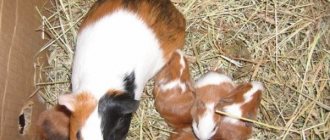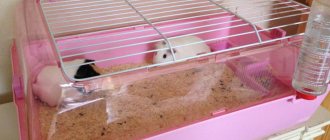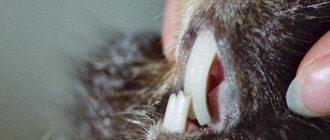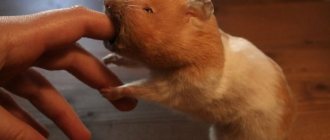How to determine pregnancy in a hamster?
It must be said that if the moment of mating was not noticed, then it is unlikely that it will be possible to immediately determine whether the female is pregnant. This can only be assumed by changed behavior. The following signs are possible:
- increased excitability and aggressiveness or, conversely, complete calm and relaxation;
- collecting materials for the nest;
- increased appetite.
The most obvious indicator is an enlarged abdomen, but if this becomes noticeable, it means that labor is coming soon. You can also determine pregnancy by the cessation of estrus and swollen nipples.
Photo of a pregnant Syrian hamster
Establishing pregnancy
So, we found out at what age a female is able to become pregnant and how long this period lasts. Now let's find out how to understand that a female hamster is pregnant.
- The first sign is a uniformly rounded belly. But it can only be distinguished from the 10th day of pregnancy.
- The second sign is the sudden and pronounced appearance of the nipples. Typically, a female hamster's nipples are light and pale. During pregnancy, they become bright pink and stand out against the background of the fur.
- The third sign is an increase in appetite. The expectant mother eats everything in her bowl with the energy of a vacuum cleaner. And he looks through the bars of the cage at the owner, waiting for more.
- The fourth sign is a change in behavior. An affectionate and tame girl becomes a real fury. When trying to pick her up, he uses his teeth.
- The fifth sign is nest building. The future hamster mother begins to fuss and build herself a nest from scrap materials.
If the owner notices these signs in his pet, the pet store will sell him a lady with a “surprise”.
How long does a hamster's pregnancy last?
For different species of hamsters, the gestation period varies quite significantly. Gestation period in days:
- Syriac – 16 – 18;
- Dzungarian, Chinese, Campbell - 18 - 21;
- Roborovsky – 23 – 30.
If you carefully examine Syrian hamsters a week after mating, and Djungarian hamsters after 9 days, you can feel small fruit balls in the stomach. At the same time, the nipples swell and weight begins to gain. If this does not happen, you need to look for deficiencies either in the diet or in the pet’s health.
Complications during childbirth
Complications can often occur during pregnancy, childbirth and afterward.
Toxicosis
Females experience toxicosis in the last days of pregnancy. There is no cure for this condition, but the consequences can be serious: the female and her cubs die during or after childbirth.
Death of fetuses in the uterus
If a mother gives birth to still babies, it means they died in the womb. This occurs due to poor nutrition, infections, age and physiological characteristics. If after this you do not undergo surgery to remove the uterus, the hamster will subsequently die from blood poisoning.
Pathology of childbirth
If labor is protracted, you should immediately consult a doctor. This situation occurs due to the age of females, whose pelvic bones become inelastic over time, due to the large size of the fetus.
Mastitis
The disease occurs after childbirth and leads to a lack of milk in the breasts, and also inflames them.
Endometritis
The disease causes inflammation of the uterus, characterized by bleeding that lasts more than three days.
Does pregnancy differ between species?
In the table we note what behavioral features are characteristic of different hamsters.
| Aggression towards the male | Nesting behavior | |
| Syrian | It appears brightly, the female can injure or even kill the male, after mating it is necessary to place them in different cages | Very pronounced |
| Dzungarian | Maybe, but sometimes absent (manifests individually), it is recommended to separate | Characteristic |
| Campbell | The male can be with the female and even participate in raising the offspring | Present |
Selecting hamsters for mating
Breeding small rodents should not be considered as entertainment. Pets will need to be looked after properly. How healthy the female and babies will often depend on the competent actions of the owner. You should start by selecting a couple of manufacturers.
In general, choosing a pair of hamsters for mating is not a difficult task. The ideal age for mating is 3.5 months. In theory, rodents can mate as early as one month of age. But experts do not recommend doing this. The hamster's body is still fragile. Problems may arise during pregnancy and childbirth. And even if a hamster is able to bear offspring without complications, she will face health problems in the future. In addition, females who give birth at 3-5 weeks of age usually do not have enough milk. Accordingly, it is difficult for them to feed their babies. For a male, mating at such an early age is also not desirable.
In addition to age, pay attention to the following indicators:
- constitution and physique of rodent producers;
- hamster and hamster weight;
- quality of wool and its color,
- health status;
- maternal qualities;
- breed.
It is recommended to breed Djungarian and Syrian rodents at home. Both breeds rarely show aggression towards people. Often the cause of such aggression is the actions of people. But the Dzungarians and Syrians are merciless towards each other. Therefore, it is not worth keeping Djungarian and Syrian rodents together. In addition, for breeding work it is worth choosing representatives of the same breed. It is worth noting that jungarians live longer.
Constitution and physique
Small rodents will not have large offspring. Therefore, we choose large animals with a strong constitution for breeding. But, there is a difference between large and fat pets. It is not recommended to breed animals that are obese. And fat females often cannot have offspring.
Hamster weight and hamsters
The weight of rodents should be appropriate for their age. If rodents weigh less than they should, it means they most likely have health problems or are not getting enough nutrients. And this will negatively affect the health of children.
The weight of the male should be greater than the weight of the female. This is due to the fact that females become aggressive during the hunting season. They can not only injure the male, but also kill him. But the difference between the mass of rodent producers should not be significant.
Coat quality and color
The condition of the coat indicates the health of the rodent. Therefore, for mating, we select individuals who have an ideal coat. In males, the color should be well expressed.
You can breed pets of different colors. However, it is not known what color the offspring will get. But, there are some prohibitions. Tangerine hamsters of the Djungarian breed cannot be mixed with each other. Rarely do dungarians in this case produce viable offspring. Rodents of other colors can be safely mated. Before purchasing a breeding pair, make sure that their offspring will, in theory, be viable. How it turns out in practice depends on many factors.
Health status
We select individuals with good genetics who do not have a tendency to certain diseases. Here it is worth mentioning that the female is ready to bear offspring once every 2 months. But frequent childbirth will have a negative impact on the pet’s health. In addition, each subsequent offspring will be weaker than the previous one.
Maternal qualities
Hamsters are fertile. But not all females have a well-developed maternal instinct. Initially, it is impossible to understand which females will become good mothers. In the process of work, cull individuals who do not look after their babies well or are prone to eating their offspring.
Do false pregnancies occur in hamsters?
A situation is possible when all the signs are present, but labor does not occur. In this case, we can talk about a false pregnancy. This happens to hamsters. In addition, under the influence of stressful situations, the formed embryos can simply dissolve. If such failures occur in pets, it is better to consult a veterinarian.
Pregnant Djungarian hamster
How do hamsters mate?
The entire mating process of these rodents takes about half an hour, although sometimes 5 minutes is enough. Within 30 minutes, the male makes several cages, if the female allows it. Keeping a couple in the same cage for more than 45 minutes is not recommended. If mating does not occur, then mating is postponed for some time.
The difficulty of mating hamsters is that young males have no experience. In this case, pregnancy may not occur the first time. If the female is in heat, the pair is brought together again after 3–5 days.
Hamsters are energetic animals, so males get very tired during the mating process. If the hamster lies down after mating and does not move, then there is no need to panic: he is just tired (he may even seem dead).
Caring for a pregnant hamster
First of all, the female needs rest during this period. As soon as it is determined that pregnancy has indeed occurred, you need to move the cage to a quiet place. It is better to replace the usual housing with a sufficiently voluminous glass container to prevent the babies from falling out through the bars in the future. It is necessary to provide the hamster with material for building a nest; this can be paper napkins without dyes.
The house must be cleaned regularly and even more thoroughly than usual, since during this period the female diligently stores food, which can spoil.
Adult Djungarian hamster
You should pick up your pet carefully and only if absolutely necessary. At the same time, you should take care to protect your hands (for example, with gloves), otherwise the hamster may scratch or bite.
Approximately 4 days before giving birth, all contact with the animal should be stopped.
Reproduction of Djungarian hamsters: arguments against
Less life expectancy
The hamster already lives for a short time, and if the body is exhausted by producing offspring, it lives almost twice as long. If the pet does not die due to birth pathology, the breeder maintains until death a female older than a year, which can no longer make a profit.
Less communication
In order not to provoke cannibalism (eating her own young), the female needs to be provided with privacy. During pregnancy, when the animal is preparing the nest, and then during lactation, it is undesirable to pick up the female or disturb him in any other way. This must be taken into account if the rodent belongs to children.
Requires time and financial investment
Dwarf hamsters will grow up wild if the young are not tamed. It is necessary to handle hamsters daily, showing patience and caution. This takes a lot of time, and you also need to organize feeding, change the water, and clean the cages.
Before placing young animals, the sex of each animal must be determined. Hamsters need to find owners. New owners are interested in many questions about maintenance and nutrition; the breeder will have to answer them, unless he sells the cubs in bulk to the poultry market.
Breeding Djungarian hamsters at home can be a very interesting activity. The nursery will not begin to generate income until it has earned an excellent reputation. Until then, you can only rely on the sale of the offspring to cover the costs of feed and accessories.
Reproduction of Djungarian hamsters 4.8 (96.49%) 114 votes
Nutritional features of a pregnant hamster
In order for the female to bear and raise healthy young without being harmed, her diet must be supplemented with calcium, protein foods and vitamins. The following products should be included in the menu:
- chicken meat;
- low-fat cottage cheese;
- eggs;
- vegetables (beets, carrots);
- sprouted cereal seeds;
- greens, juicy herbs.
Of the first three listed components, one should be in the diet daily. You need to be careful with green and succulent foods so as not to cause diarrhea in your pet, but they must be included.
Little hamsters
The lack of calcium can be compensated for by adding a tablet containing this element, or simply crushed chalk, to drinking water. The same can be done with ascorbic acid.
It is better not to give perishable foods in large quantities, as the female can hide them, and this will further contribute to the development of various infections.
Important points during pregnancy
The gestation period for hamsters varies, depending on the breed of the animal. Hamsters begin to become pregnant at different ages, the most suitable being 4-10 months. But the chances of getting pregnant appear at 1-3 months.
The imminent appearance of offspring in a hamster radically changes the life of the owner and the animal itself. Firstly, it is necessary to separate the pot-bellied animal from the rest. Fights may occur between the female and the male, and as a result, someone will die. A pregnant pet becomes aggressive, and this behavior can also be observed while feeding the cubs.
The owner must move the animal into a glass container before giving birth. This is due to the fact that babies can fall out of a regular cage. Be sure to fill the bottom of the new housing with sawdust so that the layer is 5 cm. Water is suspended so that the kids do not reach it and drown. All entertainment toys of the animal are removed from the cage; they can be harmful to the life of the hamsters. Nothing should interfere with the mother during feeding.
During the first period of fruiting, tactile communication is still possible, but when the end of gestation comes, the pet cannot be touched. The female will be able to give birth on her own, without human help, especially since during this period she is very angry towards her owners.
Pet's appearance
A pregnant pet will gradually increase in size. The appearance of the Dzungarian breeds resembles a pear. It is difficult to find out that a Djungarian hamster is pregnant, since it has long and fluffy hair. The size of the abdomen depends on the number of offspring and the period. The nipples gradually enlarge and become visible from under the fur. In addition to external signs, there are also indirect ones, they are as follows:
lies in a ball; the appearance of anger; moves slowly and carefully; looks for secluded places to rest; prepares the place for childbirth; eats and drinks a lot.
How should I eat?
It is important to feed your pet the right and healthy foods during pregnancy. Food should be varied and healthy
The diet should consist of dry mixtures, sprouted grains, herbs, fresh fruits, and vegetables. In addition, the animal needs protein food.
Proper feeding is a must
Every day you need to give a boiled egg, low-fat cottage cheese and boiled chicken, not salted. The water needs to be changed every day, it should always be fresh. Vitamins such as glucose and calcium can be added to it. If there is one, put a small piece of chalk in the cage and let the animal chew it. It is very healthy and contains a lot of calcium.
Cleaning the cage
A general cleaning is required before giving birth in a cage. It is carried out 4-5 days before the birth itself. It is forbidden to clean 1-2 days in advance. The cage is thoroughly washed and disinfected. You cannot put down new bedding, as the female will be very nervous. At this time, it is advisable to disturb the expectant mother as little as possible. She herself prepares the house, as it will be convenient and comfortable for her.
She also stores food, so people don’t want to disturb her. Place any fabric, hay and bandages in the cage; they may be useful during childbirth. Place a small cardboard house in the shape of a house so that mothers can hide their newborn babies there. Since hamsters are nocturnal animals, it will be easier for them to give birth at night. If labor begins during the day, hang a towel on the cage so that the female thinks it is night.
How to recognize the birth process
Childbirth lasts approximately 3-6 hours for a dzhungarik. They usually do this on their own. It is forbidden to touch the mother during childbirth and after. It is also prohibited to do the following processes:
- make a lot of noise;
- make sudden movements near the animal;
- look at her and the babies, and also touch her with her hands.
If a mother is stressed, she may not want to feed her babies or eat them at all. She and the newborns should not be disturbed for 16 days. During this period it is forbidden to clean the cage
You can tidy up on day 10, but be careful and don’t touch the children
If you do not follow these rules, you may not be able to breed pets. If bearing offspring was difficult, then the female may treat the children poorly and not accept them. If during fruiting the female does not receive the necessary food, mainly protein products, then she can feast on her children.
Solo content or in company
Campbell's hamsters get along well together. Sometimes the female and male jungariki are loyal to each other. But this is rather an exception to the rule. Fighting for territory is more typical for these rodents, so it is better to keep them separately, placing the female with the male only during mating. Even a Campbell's hamster will do better alone before giving birth.
Don't handle small hamsters with your bare hands
When can you take hamsters away from their mother?
Hamsters are born absolutely helpless: they are blind, deaf, completely hairless and red; for minimal orientation in space and finding the mother, the babies have a slightly developed sense of smell. In general, they are completely dependent on their mother and are very vulnerable - little hamsters will not survive without their mother until they are 10 days old!
Some development features:
- on the 5th day the first fur appears;
- at the age of a week, babies begin to try solid food;
- on the 14th day the eyes begin to open;
- On days 20–21, lactation ends completely and the babies switch to independent feeding.
Did you know? At birth, the weight of a baby hamster does not exceed 2 g, and its size is only 10
–
15 mm!
Around this time, they can be taken from their mother and placed in separate cages. The maximum period until which animals can be kept together is 5 weeks. Keeping pets together for longer is very dangerous, since by nature they are loners and are very jealous of their territory.
Thus, the appearance of offspring in hamsters is a rather exciting, but extremely responsible process. You should not allow pets to reproduce at random, because pregnancy and childbirth are a difficult task for females. Therefore, the birth of small hamsters must be approached responsibly, the intervals between pregnancies must be observed, the female must be given the opportunity to fully recover and the most appropriately provided comfortable conditions for the pet so that the life of her and the babies is safe!
How does childbirth proceed?
Hamsters usually do not require assistance during childbirth. The only exception is when the time of mating is known exactly and the hamster is already “overcoming” her term, then it makes sense to contact a veterinarian. Moreover, for about 4 weeks after the birth of the offspring, there is no need to disturb the female, just carefully add water and food. Even cleaning should not be done for 8 days, and then carry it out carefully, without touching the nest.
During normal labor, labor lasts about 3 hours; if it lasts up to 6, this is still within normal limits. The hamsters appear at intervals of approximately 5 minutes, completely without hair, with their eyes and ears closed. The female gnaws the umbilical cord and eats it along with the amniotic sac of each baby. When the offspring are numerous, the mother may not have time to cope, then some of the hamsters die.
All hamsters are born blind
If it is a Syrian hamster, it is absolutely forbidden to interfere. For the first two days, it is not even recommended to remove dead hamsters. You can try to help the baby dwarf, take it (not with your bare hands) on a napkin, free it from the bubble and gently massage it. Then you need to return it to its mother and see if she accepts this hamster. If the female refuses to feed, you will have to feed him artificially.
A female hamster can give birth to from 4 to 12 babies (there are known cases of the birth of 18 hamsters), but she, as a rule, eats sick and non-viable ones. A hamster eats or refuses to feed its offspring in several cases:
- if you feel weak or unhealthy (with an unbalanced diet);
- when she was disturbed (due to stress);
- if he senses a foreign smell on the cubs.
After 4-5 weeks, the hamsters become adults and need to be placed in separate housing; only females can be left with their mother longer.
Features of reproduction
Among the people, hamsters are known as very prolific animals, although this is only partly true. In captivity, hamsters actually breed all year round, but in the wild they obey instincts and reproduce only in the spring and summer. On average, a female gives birth 2–4 times per year, and the number of cubs in a litter varies greatly - from 1 to 18, but on average 8 animals are born in a litter.
The ability to reproduce offspring occurs already at the age of 1.5–2 months, although at such an early period pregnancy may not end successfully. It is optimal to mate a female from 4 months and a male from 3 months. In this case, the male can be used as a sire until the age of 10 months.
Did you know? Did you know? The most numerous offspring of a hamster is a litter of 26 cubs, which was produced by a hamster from the American Miller family in 1974.
Gestation lasts from 15 to 22 days and the very next day after the babies appear, the female hamster is physiologically ready for a new conception. Considering the life expectancy in captivity is up to 3, maximum 4 years, complications may occur during pregnancy already at the age of 1–1.5 years. It is known that nulliparous animals live longer than females that give birth.
Nutrition for hamsters and female hamsters after birth
The female's diet after childbirth should remain enhanced, since a lot of energy is spent on lactation. Even with such nutrition, the hamster loses up to 25% of its weight during this period. All products that were given to the animal during pregnancy remain on the menu. It is also necessary to monitor the drinking regime in order to produce a sufficient amount of milk; the female needs a lot of liquid.
Newborn hamsters eat baby food
Small hamsters, when they stand on their legs, become very active, and they also require a large amount of calories. Solid foods are introduced gradually; canned food for children can be used. Among cereals, imported small grain mixtures are best suited.
If you follow all the necessary recommendations, you can get healthy offspring from one female 3-4 times during her life. The most suitable age for a hamster to give birth is from 3 to 12 months.
Great article 24
Pairing
To ensure that pet hamsters produce their intended offspring, keep males and females separate. The reproductive age of females ends at 1.5 years. Some individuals lose the ability to reproduce at the age of 1 year. As for the males, they are ready to mate at the age of 150 days. They retain the ability to reproduce throughout their lives.
Signs of female and male readiness for mating
Mating occurs during the female's estrus. And the last one occurs, on average, once every four days. It lasts 14 hours. But this is an average. Sometimes the heat ends 4 hours after it starts. Sometimes it lasts for 24 hours. If you place a male in a cage with a female whose heat has ended or has not yet begun, then a fight cannot be avoided. Therefore, you need to carefully monitor the behavior of your furry pet. During estrus, the hamster begins to take a characteristic mating position.
As for genetics, during estrus the female develops mucous discharge in the tail area and has a musky odor. As a rule, estrus begins in the evening. It is also common for a female to lose her appetite during estrus.
Males do not have a specific period in which they are ready to mate. If the female shows interest in him, then he is ready to mate at any time. If the female reacts aggressively, then he does not have sexual desire.
Some hamsters do not go into heat in winter. This is explained by the fact that rodents hibernate in nature. Accordingly, they do not reproduce. And if the temperature in the apartment drops below 20 degrees, natural instincts are triggered.
Choosing a mating site
Before hamsters begin to mate, they must be placed in the same cage. Experts recommend choosing neutral territory for mating. It does not have to be an equipped cage. A regular shoe box will do. In addition, it will be easy to get animals out of it if they start a fight. But you should not separate rodents with your bare hands. Wear old leather or thick textile gloves.
Alternatively, mating can be carried out in the male's cage. It is strictly forbidden to move a male into a female's cage. Since the female does not always allow the hamster to approach her, even during estrus, it makes sense to purchase several females.
Human actions during mating
Mating lasts from 5 minutes to several evenings. During mating, pets need to be monitored. As soon as fertilization has occurred, the female becomes aggressive. This applies even to the peaceful Djungarian rodents. So that she does not harm the male or he does not injure her during the fight, we separate the animals. If mating is divided over several evenings, place the hamsters in different cages during your absence.
After mating, we do not place the hamster with the pregnant female. Males do not have a developed paternal instinct. He will not care for a pregnant hamster and its offspring.
Pregnancy does not always occur after mating. Therefore, the procedure sometimes has to be repeated several times.
Sometimes after mating, the male, having spent a fair amount of energy, lies motionless for a long time. This is normal.
Offspring of Djungarian hamsters
As a rule, a female Djungarian hamster gives birth to from 2 to 9 cubs at a time, although there are known cases of heroine mothers who gave birth to as many as 18 small hamsters at once. If the next day after birth you are missing several cubs, most likely the mother hamster simply ate them (animals always do this with weak and sick cubs and you should not interfere in this process).
Small hamsters are born blind and without fur. Their eyes will open only when they are 2 weeks old, and then the first fluff on the body will begin to appear.
It is strictly forbidden to pick up small jungarians! Your desire to admire and touch the cute tiny creatures can end very badly - the mother hamster may simply refuse to feed them and they will die. Therefore, observe - observe, but you should not touch or interfere.
Provide the nursing mother with a good diet and ensure that there is always clean and fresh water in her drinking bowl. And, the female Djungarian hamster herself will do the rest - she will feed and raise her hamsters.
When the hamsters are a month old, they can be considered adults and independent and they no longer need maternal care, therefore, you can safely put them in another cage.
And, finally, it is better to isolate the father of the family from small cubs , since the animal instincts in him will take over, and he can simply eat all his offspring !
Following the life of Djungarian hamsters is quite an interesting activity. However, remember, you can monitor, care, help, but not interfere in any way with the processes that Nature governs. Good luck to you!
Go to the description of feeding Djungarian hamsters.
We are waiting for your feedback and comments, join our VKontakte group!
nutriacultivation.ru
Peculiarities of cohabitation of a pair of Djungarian hamsters
Despite the fact that you decided to take a pair at once and motivated this by the fact that your hamsters would not be bored, experienced hamster breeders (there are such!) still advise keeping different-sex Djungarian hamsters in different cages and uniting the family only for mating periods. Why? The fact is that the male jungarik and the female jungarik, despite the fact that by chance they are now husband and wife, will still fight for territory, and in the process of such a fight they will have scratches, bites and others injuries. Therefore, in order to avoid such family bloodshed, it is better to keep them separate. Although, as an exception, there are known cases when a male and a female live in perfect harmony and do not conflict over the centimeters of their cage, but this is extremely rare...
But, if you do not give up hope of living together (or you feel sorry for buying another cage), you can place the hamsters together, but at the same time carefully observe their behavior for several days. If there are no conflicts, that’s good; if the dear ones scold, put them in different cages.
It is noteworthy that, as the experience of hamster breeders shows,
Most often in such conflicts and battles for the cage and clarification of the relationship “who is the boss”, the female wins, and the male almost always yields to her.
In order to prevent the development of possible conflict situations, it is also recommended to have a couple at the same time and of the same age. It is not worth adding a new female who is younger than him to a permanent resident of the cage; the rodents may begin to conflict. And finally, a little secret on how to encourage your hamsters to each other and help them develop a warm relationship.
Place the hamsters in one cage and shine a bright lamp light on it. Naturally, your hamsters will not like this behavior and the dwarf hamsters will try to hide from the bright light in the dark. But there is only one dark corner, so they will have to, willy-nilly, but make friends with each other...
Pair selection
To breed Djungarian hamsters, you need to take the choice of future parents very seriously. To regularly produce offspring, you will need at least one male and 2-3 females. It is better to purchase hamsters from different breeders so that they are definitely not related.
When purchasing, you should evaluate the general condition of the rodents:
- Healthy Djungarians have smooth, clean fur.
- An unkempt and disheveled coat indicates poor health of the animal.
- You should pay attention to the muzzle - normally it is dry, and the eyes are clean.
- There should be no bald spots or scratches on the Djungarian's body.
When breeding hamsters at home, interbreeding should be avoided. It is impossible to breed Djungarians with Campbells, despite the external similarity.
When mating two species, you may encounter complications during childbirth, including the death of the female.
Attention! When selecting a pair, you will need at least a superficial knowledge of genetics. Mating dzhungarikas with tangerine color is unacceptable, because the descendants will inherit the lethal gene, that is, they will not be viable. The same thing will happen when mating two pearl-colored rodents.
What to do when hamsters are born
So what to do, how to help so that the hamster gives birth to healthy babies? By and large, you don’t need to do anything. The process usually occurs naturally.
However, there are exceptions. It happens that small hamsters are born too quickly and there are too many of them in the litter. The female may not have time to help all the newborns; some may suffocate in the amniotic sac. To prevent such a situation, you need to carefully monitor the process and be ready to help at any time.
In an emergency situation, proceed as follows. Gently wrap the newborn in soft cloth and massage his body, removing mucus and amniotic sac. Newborn hamsters require careful handling.
Under no circumstances should you touch babies with bare hands; you must use cloth gloves. In this case, the human smell will not be transferred to the baby. Otherwise, the mother may not accept the newborn into the family, and this is definitely fraught with death for the hamster.
Another possible complication is that the new mother did not gnaw the umbilical cord. You will need to cut the umbilical cord near the tummy yourself using sterilized scissors.
What to feed a newborn hamster
After giving birth, the pet needs to be provided with comfortable conditions. Excessive anxiety can lead to the female refusing to feed her babies. Other family members and children should not have access to the nest with newborns.
The birthing process is quite energy-intensive; the female can lose up to 1/3 of her normal weight. It is recommended to support the hamster's body with a well-chosen, balanced diet. You can feed your postpartum hamster within 30 minutes after birth. During long labor, she can eat even in the intervals between the appearance of babies.
The postpartum diet must be increased by 100%, with the protein content in the diet being at least 20% and fat 10%. The menu is made up of grain mixtures and various additives:
The diet is supplemented with boiled eggs, cottage cheese and chicken meat. Provide the female with constant free access to fresh drinking water.
Tips for creating a diet for a pregnant female
Pregnant females have very different nutritional needs from normal females. Record short periods of fetal development lead to exhaustion of the mother’s body. The diet should consist of high-calorie food, which at the same time is easily digestible, providing the female with useful vitamins and microelements.
Juicy food is a storehouse of benefits for a hamster
Carrots, pumpkin and zucchini are allowed. You need to give your pet a piece of it every day. You can diversify your diet with dill or other dried herbs. Sprouts of wheat and oat seeds are useful. Vegetables should ideally be from your own garden or at least with a minimum content of harmful substances: it is better to buy them at the market rather than in the supermarket. Before serving, any product must be washed and peeled.
Apples and pears should be excluded from the diet.
Protein food is the basis of a pregnant female’s diet
Protein is essential for the hamster to develop normally. Permitted products include:
- boiled rabbit, chicken or beef without salt;
- baby meat puree from beef or turkey;
- quail or chicken boiled egg;
- low-fat dairy products without chemical additives and dyes with a fat content of no more than 1%.
Dry food is a necessary source of energy
This type of product will provide the animal with additional energy, which is vital for bearing fruit. The main requirement is high quality food, and it can be safely given to an animal in unlimited quantities. It is worth remembering that pregnant animals eat almost 3 times more than usual. A double portion will be needed after a week after mating.
Water - what is important to know?
Many people are concerned about their pet drinking too much during pregnancy, but this is a completely normal occurrence. It is necessary to change the water daily and ensure that the hamster always has it available. To improve the vitamin balance, you can add special liquid supplements for pregnant rodents.
What conditions need to be created for successful reproduction?
To encourage hamsters to mate after uniting them under one roof, you should place a lamp in the immediate vicinity of the cage and direct the light from it into the cage. In this case, the animals will look for a dark corner in their home. This will certainly bring them closer.
The best option for mating would be a separate cage, carrier, or box . This way you can avoid conflict. If this is not possible, then the female is placed with the male, and not vice versa.
The mating cage should be spacious. The room temperature is not lower than 20°C and not higher than 25°C. The cage should be installed in a secluded place where there are no drafts, noise, heating devices, and away from other pets. It is advisable to remove all gaming accessories from it.
Find out more about hamsters: what breed of pet hamster to choose, how long do hamsters of different breeds live, how to train a hamster to respond to its name.
Do not abandon animals immediately after joining without supervision. If a serious fight breaks out, they will need to be seated. You can leave them alone only if it is clear that they like each other.
Since after conception the female will begin to build a nest, she needs to put materials in the cage - rags, cotton wool, clean paper, hay. Placing newspapers in the cage is strictly prohibited.











